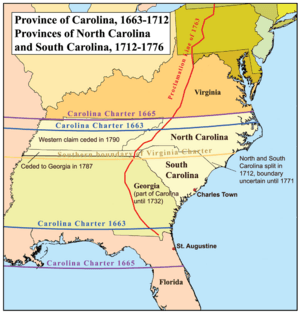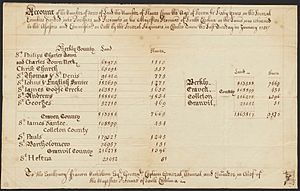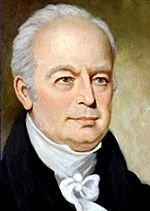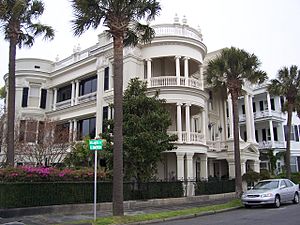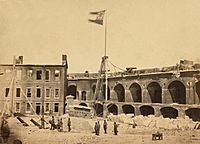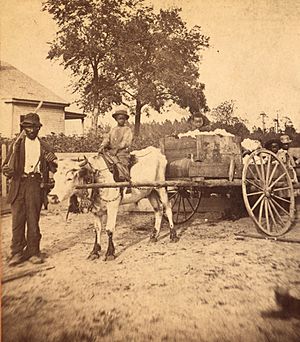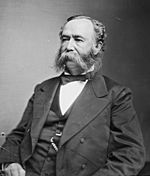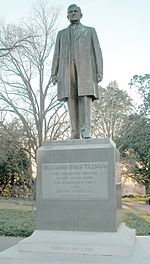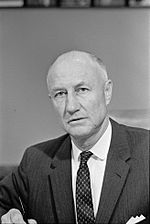History of South Carolina facts for kids
South Carolina was one of the original thirteen colonies that formed the United States. European explorers first arrived in April 1540. They brought new diseases that sadly harmed the local Native American people, who had no protection against them. In 1663, the King of England gave land for the colony to eight special owners.
The first settlers came to Charleston in 1670. Many were wealthy farmers and their enslaved people from Barbados. They began growing valuable crops like sugar and cotton. In 1712, the Carolina area was split into North and South Carolina. After a conflict called the Yamasee War (1715–1717) with Native Americans, the colonists took control from the owners in 1719. South Carolina then became a "crown colony," meaning it was directly ruled by the King of England.
In 1765, South Carolina joined other colonies to protest new taxes from Great Britain. It played a big part in resisting British rule. South Carolina became independent in March 1776, joining the fight for freedom. The Revolutionary War was tough in South Carolina from 1780–81. The British invaded and captured the American army, but they were eventually forced out. South Carolina was the eighth state to approve the U.S. Constitution on May 23, 1788.
After becoming a state, South Carolina's economy relied on growing cotton, rice, and indigo on large farms called plantations. Enslaved people did most of the work. The invention of the cotton gin made it easier to process cotton. This helped cotton farming spread to more areas. For a long time, wealthy plantation owners controlled the state's politics. In the early 1800s, leaders like John C. Calhoun made South Carolina a powerful voice in the South. The state argued against federal taxes in the 1830s. It also insisted on its right to have slavery in new territories.
When Abraham Lincoln, who opposed slavery's spread, was elected president in 1860, many people in South Carolina wanted to leave the United States. In December 1860, South Carolina was the first state to break away. In February 1861, it joined the new Confederate States of America.
The American Civil War started in April 1861. Confederate forces attacked Fort Sumter in Charleston harbor. After the Confederacy lost the war in 1865, South Carolina went through a period called Reconstruction (1865-1877). The war ruined the state's economy. South Carolina remained one of the poorer states because it still relied heavily on farming. During Reconstruction, the U.S. government put the army in charge. It allowed formerly enslaved people (Freedmen) to vote. It also stopped former Confederates from holding office. A new government, supported by Freedmen and others, created public schools and social programs. The new state constitution they passed lasted for 27 years.
In the late 1800s, conservative Southern Democrats regained power. They passed "Jim Crow laws" in the 1880s. These laws created public segregation and controlled African American workers. After 1890, most Black people lost their right to vote. Public schools, especially for African Americans, did not get enough money. Most people lived on small farms. Many worked as tenant farmers or sharecroppers. Factories, especially textile mills, began to grow in the Piedmont area. They processed cotton into yarn and cloth.
In the early 1900s, many Black people left South Carolina for northern cities. This was called the Great Migration. During the Jim Crow era, segregation was very strict. It limited African Americans' chances for education and political involvement. Federal Civil Rights laws in the 1960s ended segregation. They also protected African Americans' voting rights. Until the mid-1900s, South Carolina was mostly Democratic. After 1964, most African Americans became Democrats. Most white conservatives became Republicans.
In the mid-to-late 1900s, South Carolina's economy grew. Cotton farming declined due to new machines. Many farmers left agriculture for factory jobs. Service industries like tourism, education, and healthcare grew quickly. Textile factories declined after the 1970s as jobs moved overseas. By the late 1900s, South Carolina usually voted Republican in presidential elections. Its population continued to grow, reaching 5 million by 2020.
Contents
- Early History of South Carolina
- Colonial Period in South Carolina
- Revolutionary War in South Carolina
- South Carolina Before the Civil War
- American Civil War in South Carolina
- Reconstruction Era (1865–1877)
- Conservative Rule (1877–1890)
- Tillman Era and Voting Restrictions (1890–1914)
- Economic Changes in South Carolina
- Civil Rights Movement in South Carolina
- Recent Events in South Carolina
- Images for kids
Early History of South Carolina
Humans first arrived in the South Carolina area around 13,000 BC. These early people were hunters using simple tools made from stones and bones. Around 10,000 BC, they hunted large animals with spears. During the Archaic period (8000 to 2000 BC), people gathered nuts, berries, fish, and shellfish. Trade began between the coastal plain and the inland areas. Later in this period, people started growing plants and making pottery. The Woodland period brought more serious farming, better pottery, and the bow and arrow.
When Europeans first explored the area, 29 different Native American tribes lived in what is now South Carolina. They spoke different languages. Algonquian-speaking tribes lived near the coast. Siouan and Iroquoian-speaking tribes lived in the Piedmont and uplands.
Colonial Period in South Carolina
By the late 1500s, the Spanish and French had left the South Carolina area. They had tried to settle there but failed. In 1629, King Charles I of England granted land between certain latitudes. He called it the Province of Carolana, later changed to "Carolina."
In 1663, King Charles II gave the land to eight special owners called Lords Proprietors. They had helped him regain his throne. Charles II wanted Carolina to be a strong English area against Spanish claims to the south. These eight nobles ruled Carolina as their own colony. After the Yamasee War (1715–1717), settlers pressured the Lords Proprietors to give up their control. In 1719, the colony officially split into North Carolina and South Carolina. They became "crown colonies," directly ruled by the King.
In April 1670, settlers arrived at Albemarle Point. They founded Charles Town, named after King Charles II. During the Colonial Period, the Carolinas fought many wars against the Spanish and Native Americans, including the Yamasee and Cherokee tribes. In its early years, the colony's farms were small. Its wealth came from trading with Native Americans, mainly for enslaved Native Americans and deerskins.
The slave trade harmed tribes across the Southeast. It also caused more fighting among them. Historians believe that from 1670 to 1717, Carolinians sold 24,000 to 51,000 Native Americans into slavery. They sent them to places like Boston and Barbados. Farmers used the money from selling Native Americans to buy enslaved Africans. They found Africans easier to control because they didn't know the land well enough to escape.
18th Century Growth
From 1700 to 1770, the colony had many advantages. It had hardworking farmers and business people, a big harbor, and more enslaved African labor. The land was rich, and the growing season was long. Farmers grew rice and indigo as main crops on large plantations. They also grew long-staple cotton on the sea islands. As more labor was needed, more enslaved Africans were brought in. The enslaved population grew as they had children. These children were also considered enslaved. This made South Carolina one of the wealthiest British colonies. Wealthy colonists bought many services from outside the colony, like medical and legal training in England. Trade became very important for almost everyone in South Carolina during the 1700s.
Yamasee War Conflict
A group of Native American tribes united against the settlers in the Yamasee War (1715–1717). One reason was their opposition to the Native American slave trade. The Native Americans almost destroyed the colony. But the colonists and their Native American allies defeated the Yamasee and their friends, like the Tuscarora people. The Tuscarora moved north to New York. They became the sixth nation of the Iroquois Confederacy. The Yamasee population in the backcountry greatly decreased due to the war and European diseases.
Enslaved People in South Carolina
After the Yamasee War, farmers relied only on importing enslaved Africans for labor. With rice and indigo becoming major export crops, South Carolina became a "slave society." Slavery was central to its economy. By 1708, Black enslaved people made up most of the colony's population. They remained the majority in the state until the 1900s. Enslaved people built dams and irrigation ditches for rice farming. They created large earthworks to control water for growing rice. White farmers took credit for these achievements, even though the methods came from West African rice growers.
Most enslaved people came from West Africa. In the Low Country, where many Africans lived together, they developed a unique culture and language called Gullah. They mixed some English words and customs into their own. The Gullah people kept their special way of life and language. Starting around 1910, many Black people left the state in the Great Migration. They moved to northern and midwestern cities for work and better opportunities.
Low Country Settlements
The Low Country of South Carolina was settled first. Wealthy English men owned large amounts of land there, where they built plantations. At first, they brought white indentured servants from England to work. These young people worked for a period to pay for their travel. Planters also brought enslaved Africans to the colony.
In the early colonial years, the lines between indentured servants and enslaved people were not always clear. There was some intermarriage. But over time, slavery became stricter and based on race. South Carolina followed Virginia's rule: children born to enslaved mothers were also enslaved, no matter who the father was. As fewer English settlers came, planters relied mainly on enslaved Africans for labor.
Land sales were common and showed that the economy was growing fast. Land prices increased over time, just like the price of rice. However, prices dropped sharply just before the American Revolution. People worried about the future outside of English trade rules.
Back Country Settlements
In contrast to the Low Country, the back country was settled later in the 1700s. Most settlers were Scots-Irish and North British migrants. They moved quickly down from Pennsylvania and Virginia. These immigrants made up the largest group from the British Isles before the Revolution. They settled throughout the South and mostly farmed for their own needs. They usually did not own enslaved people. Because of these differences in background, wealth, and culture, there was a long-standing competition between the Low Country and the back country in politics.
Rice Farming Success
In the early period, planters earned a lot of money from two main crops: rice and indigo. Both crops needed enslaved labor. Historians now know that enslaved Africans brought their knowledge of rice farming from Africa. Exports of these crops made South Carolina one of the wealthiest colonies before the Revolution. Around the early 1700s, planters started growing rice along the coast. This rice became known as Carolina Gold because of its color and the great wealth it brought to plantation owners.
Indigo Production Boom
In the 1740s, Eliza Lucas Pinckney began growing and processing indigo in coastal South Carolina. Indigo was a plant used to make blue dyes for clothing in Europe. An "Indigo Bonanza" followed. South Carolina's indigo production reached almost a million pounds in the late 1750s. The British government encouraged this growth by paying a bonus for each pound of indigo produced.
South Carolina's indigo was not always the best quality. However, it still sold well because there was a high demand for cheap dyes. This was especially true for factories making low-cost textiles during the start of industrialization. The colonial economy also depended on selling animal furs (mostly deerskins), and timber. Coastal towns began building ships using strong live oak trees to support their trade.
Jewish Community in Charleston
South Carolina's open constitution and growing trade attracted Jewish immigrants as early as the 1600s. They were mostly wealthy business people from London and Barbados. Many were involved in the rum and sugar trades. Many also owned enslaved people. By 1800, Charleston had the largest Jewish population of any city in the United States.
Revolutionary War in South Carolina
Before the American Revolution, the British government began taxing the American colonies to raise money. People in South Carolina were very angry about the Townsend Acts, which taxed tea, paper, wine, glass, and oil. To protest the Stamp Act, South Carolina sent Thomas Lynch, John Rutledge, and Christopher Gadsden to the Stamp Act Congress in 1765. Other taxes were removed, but tea taxes remained. Soon, like in the Boston Tea Party, people in South Carolina began dumping tea into Charleston Harbor. This led to boycotts and protests.
South Carolina set up its own state government and constitution on March 26, 1776. Because of the colony's long history of trade with Great Britain, many people in the Low Country cities were Loyalists (loyal to the British King). Many battles fought in South Carolina during the American Revolution were against Loyalist Carolinians and the Cherokee Nation, who were allied with the British. British General Henry Clinton tried to march his troops north from Florida to trap George Washington. However, Clinton angered Loyalists and Patriots by attacking a fleeing American army.
White colonists were not the only ones who wanted freedom. About 25,000 enslaved people escaped, moved, or died during the war. This was 30 percent of the state's enslaved population. About 13,000 joined the British, who promised them freedom if they left their rebel masters and fought. From 1770 to 1790, the percentage of Black people in the state (almost all enslaved) dropped from 60.5 percent to 43.8 percent.
On October 7, 1780, at Kings Mountain, American militiamen attacked British Major Patrick Ferguson and his Loyalists on a hilltop. This was a major victory for the Patriots. Thomas Jefferson called it "The turn of the tide of success." It was the first Patriot victory since the British had taken Charleston.
As tensions grew, some Southern pastors became targets of King George. For example, Bullock Creek Presbyterian Church was known for its pastor, Rev. Joseph Alexander, who preached against the British King. South Carolina became a leader in the fight against British rule. Patriots later regained control of Charleston and South Carolina. They trapped British troops along a river.
In 1787, John Rutledge, Charles Pinckney, Charles Cotesworth Pinckney, and Pierce Butler went to the Constitutional Convention in Philadelphia. They helped create a detailed plan for the U.S. Constitution. The state approved the federal Constitution in 1787. A new state constitution was approved in 1790.
Scots-Irish Settlers in the Revolution
During the American Revolution, most Scots-Irish settlers in the backcountry were strong Patriots. One exception was the Waxhaw settlement, where many were Loyalists. This area had two main groups of Scots-Irish settlers. In the 1750s–1760s, Scots-Irish Americans from other states moved in. They had large families and produced goods for themselves and others. They were generally Patriots.
Just before the Revolution, another group of immigrants came directly from northern Ireland through Charleston. Most were poor and settled in undeveloped areas because they couldn't afford expensive land. Most of this group stayed loyal to the British King or remained neutral when the war started. Before Charles Cornwallis marched into the backcountry in 1780, two-thirds of the men in the Waxhaw settlement refused to join the army. The British victory at the Battle of the Waxhaws created strong anti-British feelings in the divided region. While many chose to fight the British, the British forced people to choose sides as they tried to recruit Loyalists for their army.
South Carolina Before the Civil War
South Carolina led the opposition to national laws during the Nullification Crisis. It was the first state to leave the United States in 1860 after Abraham Lincoln was elected. Wealthy plantation owners controlled the state government. South Carolina was the only state where slaveholders made up most of the lawmakers.
Politics and Slavery's Role
After the Revolutionary War, many enslaved people were freed. Most northern states ended slavery. In the Upper South, inspired by new ideas, states made it easier for slaveholders to free their enslaved people. From 1790 to 1810, the number of free Black people grew a lot.
Slave owners had more control over South Carolina's government than any other state. Wealthy planters acted like English nobles. While all white men could vote, only wealthy people could hold office in South Carolina. It was the only state where slave owners held most of the seats in the legislature. The legislature chose the governor, judges, and U.S. senators. The state's governor had little power.
South Carolina did not free enslaved people as easily as other Southern states. Most of its few free Black people were of mixed race. They were often children of wealthy planters and enslaved mothers. Sometimes, their fathers helped them get an education or learn a trade. Some planters even sent their mixed-race children to schools in the North.
In the early 1800s, the state made it harder to free enslaved people. A law in 1820 required lawmakers' approval for each freeing. It also required other free adults to say the person could support themselves. This meant free people of color could not easily free their own children if they were born into slavery.
Most of South Carolina's population was Black, especially in the Low Country plantation areas. By 1860, 57 percent of the state's population (over 402,000 people) were enslaved African Americans. Fewer than 10,000 were free Black people. A group of free people of color lived in Charleston. They were often more skilled and educated than most Black people. After 1794, Eli Whitney's cotton gin allowed cotton plantations to spread throughout the state.
By 1830, 85 percent of people on rice plantations in the Low Country were enslaved. When rice planters left the Low Country for cities like Charleston, up to 98 percent of the residents were enslaved. This helped preserve West African customs and develop the Gullah culture. By 1830, two-thirds of South Carolina's counties had populations where 40 percent or more were enslaved.
In 1822, a free Black man named Denmark Vesey planned a large uprising of enslaved people near Charleston. Vesey's plan, inspired by the Haitian Revolution, aimed for thousands of armed Black men to kill their slaveholders, take Charleston, and sail to Haiti. The plot was discovered when two enslaved people told white authorities. Charleston authorities charged 131 men. They convicted 67 and hanged 35, including Denmark Vesey. After this, white people feared slave uprisings. Charleston set a 9:15 p.m. curfew for enslaved people. A municipal guard of 150 white men was created.
Plantations in older Southern states like South Carolina wore out the soil. This caused 42 percent of state residents to leave for the lower South, where new soil was available. The remaining South Carolina plantations suffered when cotton prices dropped in 1826–32 and again in 1837–49. Many South Carolinians blamed these economic problems on federal tariffs.
Nullification Crisis
The white minority in South Carolina felt more threatened than in other parts of the South. They reacted strongly to economic problems and attempts to end slavery. South Carolina first tried to "nullify" a federal law in 1822. It adopted a policy of jailing foreign Black sailors in its ports. This broke a treaty between the United Kingdom and the United States. But South Carolina ignored complaints. Foreign Black people from Santo Domingo had communicated with Vesey's plotters. The South Carolina state Senate said preventing uprisings was more important than laws or treaties.
South Carolinian George McDuffie created the "Forty Bale theory." He said that tariffs, which were taxes on imported goods like iron and cotton products, were like a thief stealing 40 out of 100 bales of cotton from every farm. This theory was based on incorrect math. However, it was a popular explanation for economic problems. These problems were largely caused by too much cotton being grown in the Deep South, which competed with South Carolina's declining crops due to worn-out soil. South Carolinians blamed the tariff for cotton prices falling from 18 cents to 9 cents a pound in the 1820s.
While the tariff's effects were exaggerated, it did make European imports more expensive. This reduced British imports of cotton to some extent. These were mostly short-term problems before U.S. factories could compete with Europe.
The Tariff of 1828, called the Tariff of Abominations by South Carolinians, set the tax rate at 50 percent. John C. Calhoun, a South Carolina leader, secretly wrote a paper arguing that states had the right to nullify (cancel) federal laws. Calhoun believed that threatening to leave the Union would force a compromise. Both Calhoun and Robert Barnwell Rhett thought these arguments could also be used to defend slavery.
President Andrew Jackson successfully made the nullifiers back down. He allowed a gradual reduction of tariff rates. Calhoun and Senator Henry Clay agreed on the Compromise Tariff of 1833, which would lower rates over 10 years. Calhoun later supported federal protection for slavery in new territories.
Censorship and Slavery Debates
On July 29, 1835, Charleston Postmaster Alfred Huger found anti-slavery writings in the mail. He refused to deliver them. Slave owners seized the mail and burned it. Other Southern states followed South Carolina's lead in censoring anti-slavery materials. South Carolina's James Henry Hammond pushed for a "gag rule." This rule banned petitions to end slavery from being discussed in Congress in 1835. In 1856, South Carolinian Preston Brooks attacked Republican Charles Sumner with a cane. This happened after Sumner's speech criticizing slavery. This event increased Northern fears that the "slave power" threatened fair government.
Secession and the Start of War
South Carolina was the first state to leave the Union after Abraham Lincoln was elected in 1860. On December 20, 1860, South Carolina adopted a document explaining why it was leaving. All the reasons mentioned were about slavery. President Buchanan protested but did not use military force. He tried to resupply Fort Sumter, but South Carolina forces fired on the ship, forcing it to turn back.
American Civil War in South Carolina
Pre-War Tensions
Few white South Carolinians considered ending slavery. They feared that if enslaved people were freed, they would try to change white society and culture. They believed this had happened after slave revolutions in Haiti, where many white people were killed. South Carolina's white politicians were divided. Some were strong Unionists who opposed leaving the Union. Others believed leaving was a state's right.
John C. Calhoun noted that the dry Western lands could not support plantations and would remain without enslaved people. Calhoun suggested that Congress should not ban slavery from territories. Instead, each state should choose whether to allow slavery. After Calhoun's death in 1850, South Carolina lacked a strong leader to prevent more extreme actions. Robert Barnwell Rhett pushed for immediate secession.
When people believed Abraham Lincoln would be elected president, states in the Deep South held meetings to discuss their options. South Carolina was the first to do so in December 1860. On December 20, 1860, delegates in Charleston voted to leave the Union. President James Buchanan said secession was illegal but did not stop it. The first six states to secede were the largest slaveholding states. This showed that slavery was central to the decision to leave.
Fort Sumter Attack
On February 4, 1861, seven seceded states approved a new constitution for the Confederate States of America. Lincoln argued that the United States was "one nation, indivisible." He denied the Southern states' right to leave. South Carolina joined the Confederacy on February 8, 1861. This ended its short time as an independent state. Meanwhile, Major Robert Anderson, commander of the U.S. troops in Charleston, moved his men to Fort Sumter. He raised the U.S. flag there. Fort Sumter was small and outgunned by shore batteries, but it was very important symbolically. South Carolina Governor Pickens demanded that President Buchanan surrender Fort Sumter. Buchanan refused. Lincoln wanted to hold the fort to show national power. He wanted the Confederacy to fire the first shot.
About 6,000 Confederate men were around the harbor, ready to attack the 60 men in Fort Sumter. At 4:30 a.m. on April 12, after two days of talks, the Confederates opened fire. Thirty-four hours later, Anderson's men surrendered. They were allowed to leave the fort with their flag and drums. During a 50-gun salute to the U.S. flag, one gun exploded, killing a young soldier. This was the first casualty of the war. People in both the North and South rushed to join the army. Lincoln called for troops to recapture the fort.
Civil War Devastation
The South had fewer soldiers, weapons, and ships. Federal ships blocked off Southern ports. In November 1861, Union troops occupied the Sea Islands near Beaufort. This became an important base for blocking ports at Charleston and Savannah. Many plantation owners fled inland, sometimes taking their enslaved people with them.
African Americans who stayed on the Sea Islands became the first "freedmen" of the war. Under military supervision, the Sea Islands became a place for education. Northern teachers found that formerly enslaved adults and children were eager to learn. Supervisors gave plots of land to freedmen families. They began farming for themselves, growing food and cotton or rice.
Despite South Carolina's role, fighting was mostly limited to naval activities until near the end of the war. Union forces tried to take Charleston from 1863 but failed. In 1865, Union General William Tecumseh Sherman marched his army from Savannah to Columbia, then north into North Carolina. With little Confederate resistance, Sherman's troops looted and destroyed property. There was widespread anger at South Carolina for starting the war. Columbia and many other towns were burned.
On February 21, 1865, Confederate forces left Charleston. The Black 54th Massachusetts Regiment marched through the city. At a ceremony where the U.S. flag was raised over Fort Sumter, former commander Robert Anderson was joined by two African Americans: Robert Smalls, a Union hero, and the son of Denmark Vesey.
After the war, landowners struggled with the change to free labor and the destruction. The state faced an agricultural and financial downturn. South Carolina lost more young men in the war than any other Southern state. About 18,666 deaths were recorded, but fatalities might have reached over 21,000. Most men died from disease, not battle wounds.
Reconstruction Era (1865–1877)
African Americans had long been the majority of South Carolina's population. In 1860, only 2 percent of the state's Black population was free. Most were mixed-race or free people of color. They often had family ties to white families. They were skilled workers in cities like Charleston and sometimes owned land or even enslaved people. Because of their education and experience, free people of color became important leaders in South Carolina's government during Reconstruction. They made up 26 percent of Black people elected to office between 1868 and 1876.
After the war, most white South Carolinians were willing to accept President Johnson's terms to rejoin the Union. However, in 1865, the state legislature passed "Black Codes." These laws aimed to control the work and movement of freedmen. For example, Black people contracting for service were called "servants." Their employers were "masters." On farms, hours were from sunrise to sunset, except Sunday. Time lost from work would be deducted from wages. House servants had to be available all hours. They had to be "civil and polite" to their masters. Punishment could only be ordered by a judge. A strict vagrancy law kept Black people from moving freely. These Black Codes angered Northerners, who saw them as a return to semi-slavery. They were never fully put into effect.
Republican Government During Reconstruction
After winning the 1866 elections, the Radical Republicans took control of Reconstruction. The Army registered all male voters. This led to a Republican government made up of freedmen, "carpetbaggers" (Northerners who moved South), and "scalawags" (Southern white Republicans). A new constitution was created in 1868. It brought democratic reforms, including the state's first public school system. White Democrats opposed this government.
Many white people felt betrayed by their former enslaved people. Before the war, slaveholders believed they treated their enslaved people well and earned their loyalty. When the Union Army arrived, thousands of enslaved people left. This shocked slaveholders. Black people tried to protect their new rights. White people tried to regain power by denying Black people those rights and bringing back white supremacy.
Ku Klux Klan raids began soon after the war. Klan members terrorized and murdered Black people and their supporters. They wanted to bring back white supremacy. These raids were common in the upstate, peaking in 1870–71. Congress passed laws to stop the Klan. The government declared martial law in some upstate counties in October 1870. This led to many arrests. However, few people were successfully prosecuted. This weakened federal authority. Violence continued with new groups like the "Red Shirts." These groups operated openly in the 1870s. They tried to stop Republican organizing and suppress Black voting. They killed over 100 Black people during the 1876 election.
Government Spending and Debt
A main complaint from conservatives against the Republican state government was the rising state debt and taxes. White people were much poorer after the war. Much of the state's money was wasted. The state debt grew quickly. Interest was rarely paid, and the state's credit was almost gone.
The Reconstruction government created public education for the first time. It also established new charities and improved prisons. There was corruption, but mostly white Southerners benefited. They invested in railroads and other infrastructure. Taxes were very low before the war because wealthy planters did not support public programs. The needs after the war caused the state debt to rise fast. When Republicans took power in 1868, the debt was $5.4 million. By 1877, when Republicans lost control, it had risen to $18.5 million.
The 1876 Governor's Election
From 1868 on, elections saw increasing violence from white groups like the Red Shirts. In 1870, Republican Governor Chamberlain asked Washington for help to keep control. President Ulysses S. Grant sent federal troops to ensure a fair election.
Using a plan similar to Mississippi's, white South Carolinians used threats, violence, and control to influence Black voters. In 1876, tensions were high, especially in towns where Black people were a small majority. The Red Shirts held many demonstrations. They were white Democrats determined to win the elections. The Red Shirts convinced whites they could regain control. They terrorized Black people to keep them from voting. Incidents like the Hamburg Massacre in July and the Ellenton riots in October contributed to this. Armed with pistols and rifles, they rode to Republican meetings. They threatened Black men to prevent disturbances. The "Redeemers" organized hundreds of rifle clubs. They sometimes pretended to be missionary societies or dancing clubs, but they still had rifles.
They also boycotted Black activists and white Republicans who refused to vote Democratic. People lost jobs for their political views. They fought the opposition, but usually within the law. In 1876, Wade Hampton gave over forty speeches. Some Black Republicans joined him, wearing Red Shirts and parading with whites. Most white Republicans switched to the Democrats.
On election day, both parties used threats and fraud. Some counties had more votes for Democratic candidate Wade Hampton III than registered voters. The election results were disputed all the way to Washington. They played a key role in the Compromise of 1877. Both parties claimed victory. For a while, two separate state assemblies met in the State House. The Republican assembly threw out the tainted results and reelected Chamberlain as governor. A week later, General Wade Hampton III took the oath of office for the Democrats.
Finally, President Rutherford B. Hayes withdrew federal troops from South Carolina in 1877. This was part of a deal for Southern support for his presidential victory. The Republican government ended. Chamberlain moved North, and Wade Hampton and his Redeemers took control.
Historical Interpretations
White and Black people in South Carolina remembered Reconstruction differently. These memories justified their political views. James Shepherd Pike, a Republican journalist, visited the state in 1873. He wrote a book called The Prostrate State (1874). Historian Eric Foner explains that the book showed a state full of corruption. It was controlled by "a mass of black barbarism." Pike said South Carolina's problems came from "Negro government." He believed the solution was to give power back to leading white people.
Similar ideas were developed by historians in the early 1900s. They argued that corrupt Northerners controlled ignorant Black voters. They said this almost ruined South Carolina's economy and society. In this view, the heroes were the Red Shirts. They were white groups who, starting in 1874, "rescued" the state. They kept Black people from public life through threats during elections. They restored order and created a long period of peace between races.
The Black perspective, starting with W.E.B. Du Bois' Black Reconstruction (1935), looked at the period more fairly. It noted its achievements in creating public schools and social programs for all citizens. Other historians also compared Reconstruction to similar times. Their work supported the Civil Rights Movement.
In the 1980s, debates over displaying the Confederate flag were linked to these different interpretations. They also related to the century-long struggle of Black people to regain their constitutional rights after Reconstruction.
Conservative Rule (1877–1890)
The Democrats were led by General Wade Hampton III and other former Confederate soldiers. They wanted to return to the policies from before the Civil War. Known as Conservatives, they favored limited government and a friendly policy towards Black people while keeping white supremacy. They also wanted to restore the University of South Carolina to its former status. They closed the college before passing a law to only allow white students. They created Claflin College for Black students.
Once in power, the Democrats quickly strengthened their position. They tried to undo the changes made by the Radical Republicans. They pressured Republicans to resign, using violence and threats from the Red Shirts. Within a year, Democrats controlled both the legislature and the courts. Democrats investigated corruption by Republicans during Reconstruction. They dropped charges when the federal government dropped charges against whites accused of violence in the 1876 election.
With their power secure, Democrats tackled the state debt. Some Democrats wanted to cancel the entire state debt. But Charleston bondholders opposed this. Wade Hampton helped reach a compromise. By October 1882, the state debt was reduced to $6.5 million.
Other laws passed by the Conservatives helped their main supporters: farmers and business owners. Taxes were lowered. Funding for public social and education programs for poor whites and Black people was cut. Oral contracts became legally binding. Breaking a contract became a crime. People in debt to planters could be forced to work off their debt. Also, the University of South Carolina and The Citadel were reopened for elite classes and received strong state support.
By the late 1880s, the farmers' movement grew in the state. It encouraged small farmers to demand their political rights. They pushed the legislature to create an agriculture college. The legislature reluctantly added an agriculture college to the University of South Carolina in 1887. Ben Tillman inspired farmers to demand a separate agriculture college away from Columbia's politics. The Conservatives finally gave them one in 1889.
Tillman Era and Voting Restrictions (1890–1914)
In 1890, Ben Tillman ran for governor. Farmers supported him, and Tillman easily won. The conservatives did not understand how strong the farmers' movement was. The wealthy planters no longer automatically earned respect for fighting in the Civil War. Also, Tillman's "humorous and coarse speech appealed to a majority."
The Tillman movement succeeded in passing many of Tillman's ideas. These included creating a new state constitution and a state system for selling alcohol. Tillman had a "pathological fear of Negro rule." White leaders created a new constitution with rules to stop Black people and poor whites from voting. They followed Mississippi's plan, which had been upheld by the U.S. Supreme Court.
Voting restrictions were mainly put in place through difficult voter registration rules. These included poll taxes and literacy tests. In practice, these rules mostly affected African Americans and poor whites. After the new Constitution of 1895, voting was mostly limited to white people for over sixty years. This created a one-party Democratic state. White Democrats benefited because their representation in the U.S. House was based on the total state population, even though fewer people could vote. Black people were excluded from politics in every way, including serving in local offices and on juries.
During Reconstruction, Black lawmakers were a majority in the lower house of the legislature. The new rules, enforced by white officials, meant only about 15,000 of 140,000 eligible Black people could register to vote. In reality, many more Black people were stopped from voting by white registrars. Also, the Democratic Party primary elections were only for white people. By October 1896, 50,000 white people were registered, but only 5,500 Black people, even though Black people were the majority in the state.
The 1900 census showed how widespread these voting restrictions were. A total of 782,509 African Americans made up over 58 percent of the state's population. They had almost no representation. This political loss affected both educated and uneducated Black men. It meant that without their interests represented, Black people were treated unfairly. They could not serve on juries. Segregated schools and services received little funding. Law enforcement was controlled by white people. African Americans did not regain their right to vote and political rights until federal laws were passed in 1964 and 1965.
The state Dispensary, called "Ben Tillman's Baby," was never popular. Violence broke out in Darlington over its enforcement. In 1907, the Dispensary Act was ended. In 1915, the legal sale of alcohol was banned by a public vote.
Tillman's influence on South Carolina politics began to fade after he was elected to the U.S. Senate in 1895. The Conservatives regained control of the legislature in 1902. The wealthy planter, Duncan Clinch Heyward, won the governor's election. He made no major changes and continued to enforce the Dispensary Act with difficulty. The state continued to industrialize quickly. This led to a new group of white voters: cotton mill workers.
White sharecroppers and mill workers supported Cole Blease for governor in 1910. They believed Blease would include them in the state's political power. However, once in office, Blease did not start any policies that helped mill workers or poor farmers. Instead, his four years were very unpredictable. This helped a progressive leader, Richard I. Manning, win the governorship in 1914.
Economic Changes in South Carolina
In the 1880s, Atlanta editor Henry W. Grady promoted a "New South." This vision was based on a modern industrial model. By then, some South Carolinians realized that the cotton they shipped North could also be processed in South Carolina mills. This idea was not new. In 1854, a business review had praised South Carolina's potential for manufacturing. It mentioned its railroads, cheap raw materials, non-freezing rivers, and available workers. Before 1860, slavery was so profitable that it used up available money and kept Northern investors away. But now, it was time for industrialization. By 1900, the textile industry was strong in upland areas. These areas had water-power and white workers willing to move from farms to mill towns.
In 1902, the Charleston Expedition attracted visitors from around the world. President Theodore Roosevelt called for peace between the North and the South.
The Progressive Movement came to the state with Governor Richard I. Manning in 1914. The growth of bright-leaf tobacco around 1900 brought a farming boom. This was broken by the Great Depression starting in 1929. But the tobacco industry recovered and did well until the late 1900s. Cotton remained the main crop, despite low prices. The arrival of boll weevil insects greatly reduced cotton fields and yields. Farmers then switched to other crops.
Black sharecroppers and laborers began moving North in large numbers during World War I. This "Great Migration" continued through the mid-1900s. They sought higher wages and better political conditions.
Civil Rights Movement in South Carolina
Compared to places like Mississippi and Alabama, ending segregation went fairly smoothly in South Carolina during the 1950s and 1960s. However, as early as 1948, when Strom Thurmond ran for president, white South Carolinians showed unhappiness. They disliked the federal government's growing power after World War II.
Black South Carolinians had problems with the Southern idea of states' rights. By 1940, voting rules from the 1895 constitution limited African American voters to only 3,000. This was just 0.8 percent of those old enough to vote. African Americans had not been able to elect a representative since the 1800s. Hundreds of thousands left the state for industrial cities during the Great Migration of the 1900s. By 1960, during the Civil Rights Movement, South Carolina had a population of 2,382,594. Nearly 35% (829,291) were African Americans, who had been without representation for 60 years. Also, the state enforced legal racial segregation in public places.
Non-violent protests against segregation began in Rock Hill in 1961. Nine Black Friendship Junior College students sat at a whites-only lunch counter and refused to leave. When police arrested them, the students could pay $200 fines or serve 30 days of hard labor. The "Friendship Nine" chose the latter. They gained national attention for their "jail, no bail" strategy.
In 1962, federal courts ordered Clemson University to admit its first African-American student, Harvey Gantt. The state and college had tried every legal way to stop his admission. Important white leaders made sure that no violence would be tolerated. Gantt entered the school without problems. In 1963, The Saturday Evening Post praised the state's handling of the situation. Gantt graduated with honors in architecture. He later served on the Charlotte City Council and became Charlotte's first Black mayor.
In 1964, Barry Goldwater's political ideas caused many conservative white Democrats in South Carolina to switch to the Republican Party. Senator Strom Thurmond led this change. With the federal Civil Rights Act of 1964 and Voting Rights Act of 1965, the national government worked to ensure rights for Black people in South Carolina and other states. Since then, African Americans have been regularly elected to national, state, and local offices.
In 1970, when South Carolina celebrated its 300th anniversary, over 80% of its residents were born in the state. Since then, people from the North and Midwest have discovered South Carolina's golf courses, beaches, and mild climate. The state has become popular for tourism and new residents, including retirees. Descendants of Black South Carolinians who left during the Jim Crow years have moved back. Despite these new arrivals, about 69% of residents are native-born.
Recent Events in South Carolina
Economic Changes in Modern South Carolina
The rapid decline of farming has been a major change since the 1960s. As late as 1960, more than half of the state's cotton was picked by hand. Over the next twenty years, machines replaced tens of thousands of farm jobs. By 2000, only 24,000 farms were left. Fewer than 2% of the population worked in farming. Many others lived in rural areas but commuted to non-farm jobs. Cotton was no longer the main crop. Cotton lands were turned into timberlands. Until the 1970s, rural areas controlled the state legislature.
After 1972, both houses of the state legislature were divided into single-member districts. This ended the rural advantage. Combined with the Voting Rights Act of 1965, which protected African Americans' voting rights, this changed South Carolina politics. The South Carolina Democratic party, which had controlled the state for almost a century, began to decline after the 1994 elections. Most white voters had supported Republican presidential candidates since the late 1960s. They gradually elected Republican candidates to local and state offices. Republicans won almost all statewide offices and control of the state House of Representatives.
Fritz Hollings, governor from 1959–63, strongly supported development. He promoted industrial training programs and a statewide economic development plan. The end of the Cold War in 1990 led to the closing of military bases, like naval facilities in North Charleston. Finding new jobs became a top state priority. Starting in 1975, the state used its attractive climate, lack of strong labor unions, and low wages to attract foreign factories. Michelin, for example, located its U.S. headquarters in the state. The stretch of Interstate 85 became known as "UN Alley" as international companies opened operations.
Tourism became a major industry, especially in the Myrtle Beach area. With its warm climate, cheap land, and low construction costs, the state became attractive for developers. Barrier islands like Kiawah and Hilton Head were developed as retirement communities for wealthy outsiders. The state's efforts to manage coastal development faced challenges from federal court decisions. The U.S. Supreme Court ruled that the state, by banning construction on threatened beachfront property, had taken the owner's property without proper legal process. The rush to build expensive housing along the coast led to billions of dollars in losses when Hurricane Hugo hit in September 1989. Charleston was more used to hurricanes. Historical preservation groups immediately began salvage and reconstruction. One year after Hugo, the city was almost back to normal.
By the late 1980s, however, the state's economic growth slowed. South Carolina's development plan focused on low taxes and attracting low-wage industries. But the state's low education levels failed to attract high-wage, high-tech industries.
In 1991, Governor Carroll A. Campbell successfully brought BMW's only U.S. auto factory to Greer. Other auto parts suppliers also set up facilities near the factory. This shifted manufacturing from textiles to automotive.
In 2009, the state won a bid against Washington state for a large new Boeing plant in North Charleston. Boeing must create at least 3,800 jobs and invest over $750 million within seven years to get tax benefits worth $450 million.
Recent Politics
In the 1970s, South Carolina white voters elected the state's first Republican governor since Reconstruction. In 1987 and 1991, the state elected and reelected Governor Carroll Campbell, another Republican. Many politicians switched from the Democratic Party to the Republican Party. This included David Beasley, a former Democrat who became governor as a Republican. In 1996, Beasley surprised citizens by saying he could not justify keeping the Confederate flag flying over the capitol. He said that racial violence made him rethink the flag's meaning. Traditionalists were further surprised when Bob Jones III, head of Bob Jones University, agreed.
Beasley lost his reelection bid in 1998 to Jim Hodges, a state assemblyman. Hodges attacked Beasley's opposition to creating a state lottery to support education. Hodges called for new taxes to improve public education. Despite Hodges' unwillingness to join Beasley in opposing the Confederate flag, the NAACP supported Hodges. (At the same time, the NAACP called for a boycott of conferences in the state over the flag issue). Hodges reportedly accepted millions from the gambling industry.
After the election, with public opinion against video gambling, Hodges asked for a statewide vote on the issue. He said he would personally vote "no" but would not campaign against it. Critics suggested Hodges' debts to gambling interests kept him from campaigning against it. The state constitution does not allow referendums except for approving amendments. State lawmakers shut down the state's video casinos soon after Hodges took office.
Upon his election, Hodges agreed with Beasley's compromise proposal on the Confederate flag. He supported moving the flag to a Confederate monument on the State House grounds. Many South Carolinians agreed this was the only solution. They also admired Hodges' solution to nuclear waste shipments to the state. Hodges alienated moderate voters. In 2002, most major newspapers supported Republican Mark Sanford to replace him. Hodges was blamed for the state's poor handling of the Hurricane Floyd evacuation in 1999. By 2002, most funds from Hodges' "South Carolina Education Lottery" paid for college scholarships, not for improving poor rural and inner-city schools. Religious leaders criticized the lottery for taxing the poor to pay for middle-class higher education.
In the lottery's first year, Hodges' administration awarded $40 million for "LIFE Scholarships." These were given to any South Carolinian student with a B average, graduating in the top 30% of their high school class, and an 1,100 SAT score. Hodges' administration awarded $5.8 million for "HOPE Scholarships," which had lower GPA requirements.
Hodges lost his reelection campaign in 2002 to Republican conservative Mark Sanford, a former U.S. congressman.
Images for kids
-
Lord Charles Montagu, the last Royal Governor of South Carolina
-
An 1861 engraving of Fort Sumter before the attack that began the Civil War
-
Myrtle Beach, North Ocean Boulevard in 2010


